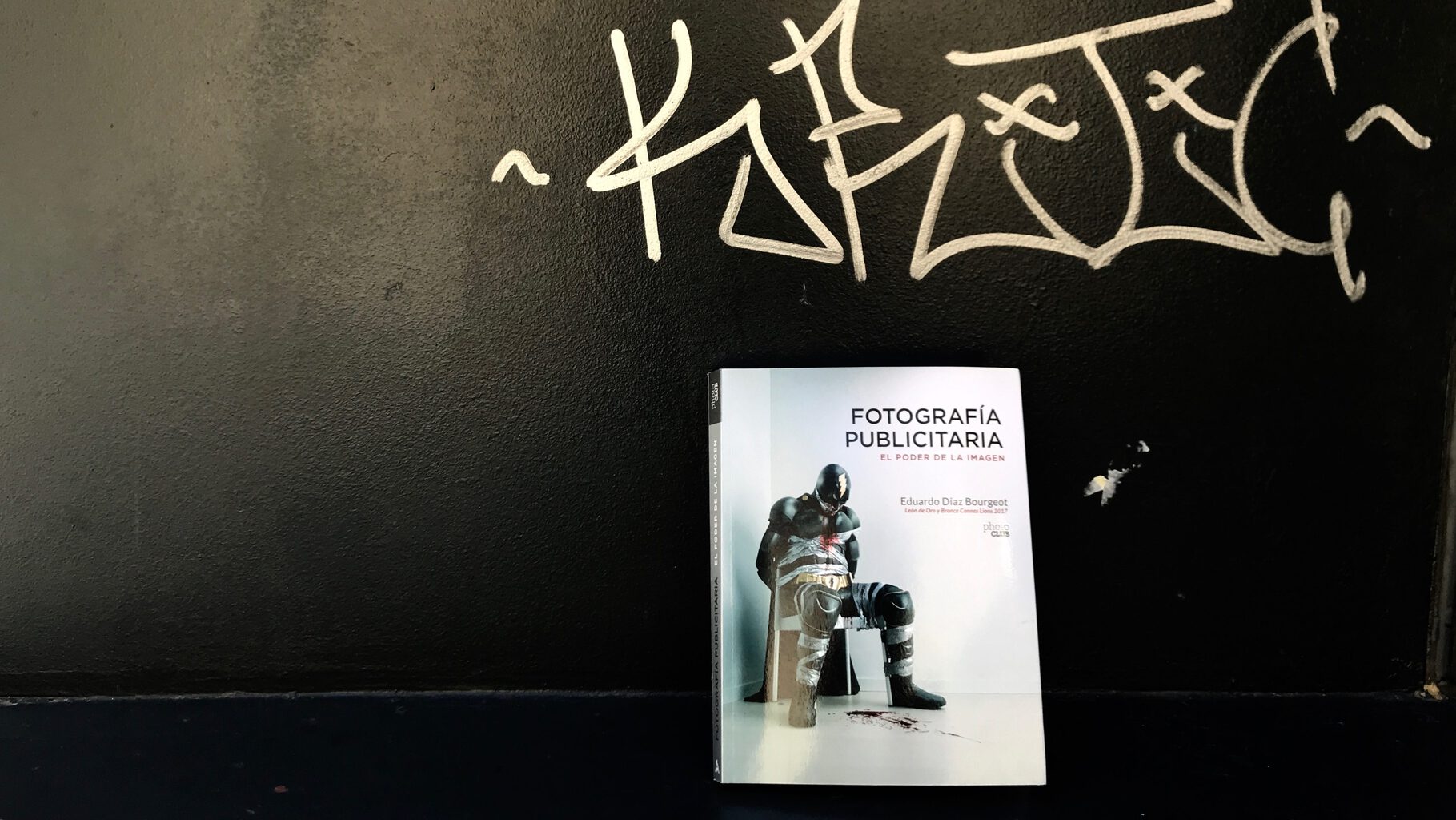Anyone who has been even slightly interested in how advertising campaigns are carried out will have seen how complex they are.
Beyond the final image that is shown to us, there is a very concrete, complete, and complex work. There's extensive market analysis, lots of psychology, and endless strategies designed to capture the viewer's attention and convey an idea that invites some action.
Our literary recommendation this month is about this type of photography that is always present around us: advertising photography .
IDEAL FOR…
This is a book for advanced amateurs who want to know other techniques for taking photography in advertising. In no case (unless you think it's really your passion and you're going to want to squeeze and decipher every word of this book) is it for someone who has just landed in photography.
On the other hand, if you have good technical knowledge, and relative experience in the world of advertising or at least a high interest in it, this book may be what you are looking for. You will be able to see the entire process that this type of photography requires, and add new ideas or techniques to your knowledge.
IT'S NOT FOR YOU IF...
If you have just landed in photography and do not yet have technical knowledge, this, at the moment, I do not think is the book you are looking for. At least, not now ;). Since it is aimed at someone who does have a fairly deep knowledge of photographic technique.
ADVERTISING PHOTOGRAPHY. IMAGE'S POWER
CHAPTER 1: INTRODUCTION. WHAT WE ARE GOING TO DEAL WITH IN THE BOOK
In this introductory chapter, the author outlines all the topics that he will deal with throughout the book, which is basically the entire process that an advertising photographer must follow, from the first intention of the client to the final retouching.
It explains how advertising photography is basically a way of expressing ideas and emotions and how its main objective is to make the viewer of the photograph immediately capture the message we are trying to convey.
CHAPTER 2: WHAT IS ADVERTISING PHOTOGRAPHY
We will learn how the objective of advertising has been transformed from simply making a product known, to transmitting a message to a certain group of people with the aim of promoting a specific attitude; how advertising seeks to have impact and originality trying to penetrate the viewer by appealing to his emotions, in a single image, in which nothing is left to chance and the result must be exactly as expected.
You will also learn aspects such as what requirements an advertising photographer needs : having many resources, a high level of responsibility and involvement in the entire process, extensive technical knowledge and ingenuity.
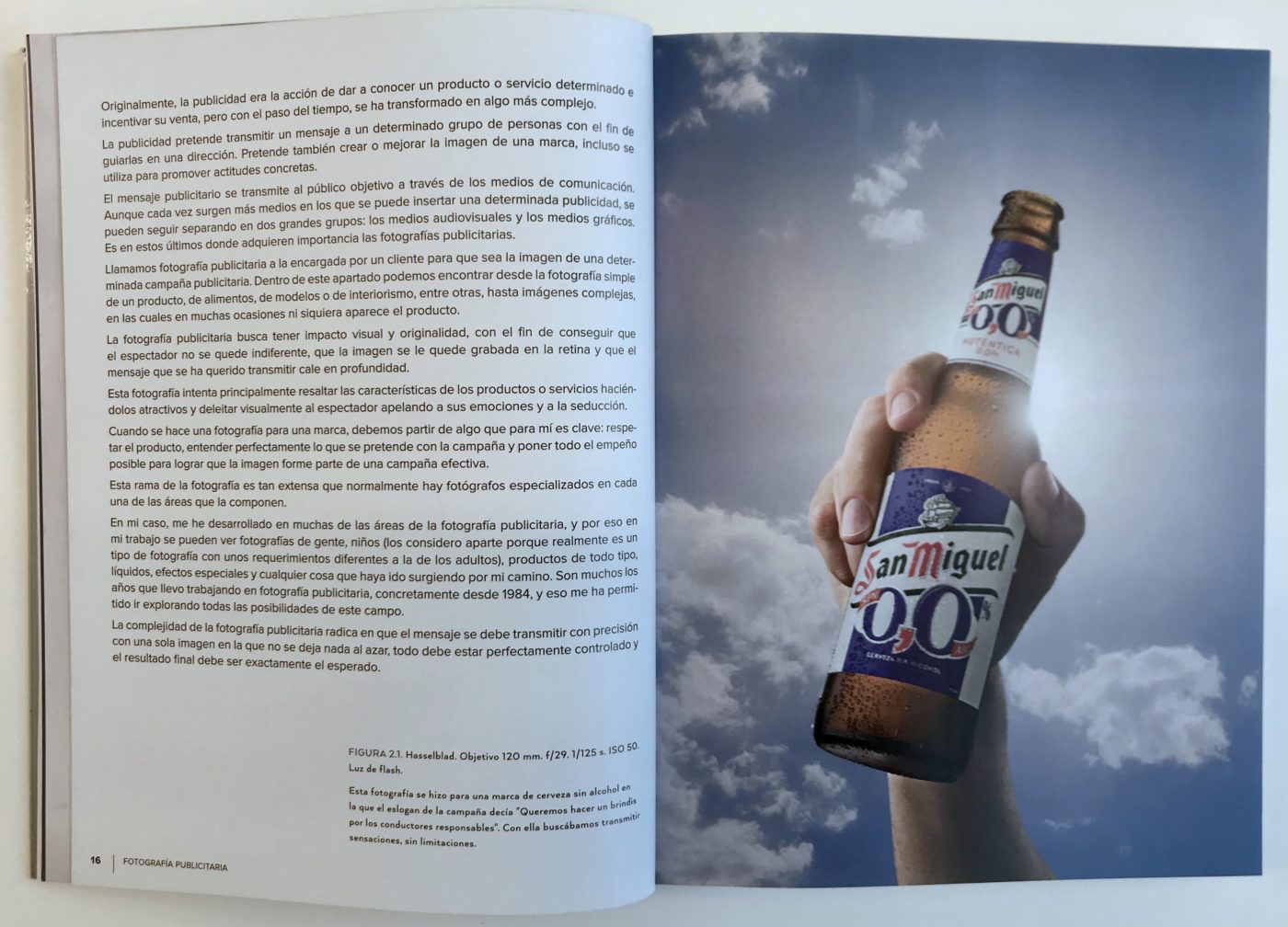
CHAPTER 3: PROCESS FOR CREATING AN ADVERTISING PHOTOGRAPH
In this third chapter you will see in detail the entire process to create an advertising photograph, from the Briefing (the document that provides the itinerary to follow for the implementation of an advertising campaign), the idea or sketch (a specific idea of how it will be concept) to final delivery after post-production.
You will know all the steps of pre-production: logistics, product preparation, hiring personnel, casting, finding and renting locations, requesting permits, contracting services, creating the set and making scenery, costumes, subpoenas etc.
You will also touch on aspects such as lighting, movement speed (fast or slow), different light conditions, type of lighting, perspectives, final resolution of the image, and optics.
You will also find a composition section: center of interest , rule of thirds, eyes, lines, horizontality and verticality, direction, negative space , color, or the background.
CHAPTER 4: WHAT EQUIPMENT WE WILL NEED
In this chapter you will see all the necessary equipment to work in advertising, starting with the lighting equipment and ending with the computer equipment.
It deals with flash lighting equipment (flashes with a generator or compact flashes), continuous light, lighting accessories (light windows, umbrellas, reflectors, honeycombs, tripods, filters...) and other accessories such as the sync cord, wireless triggers, etc.
It also explains in this chapter, the types of cameras, the different types of lenses and their main characteristics, the different tripods, remote or cable triggers.
Finally, it deals with the computer equipment: desktop computer, processor, RAM memory, graphics card, hard drive, monitor, laptop, external hard drives, memory cards or card readers.
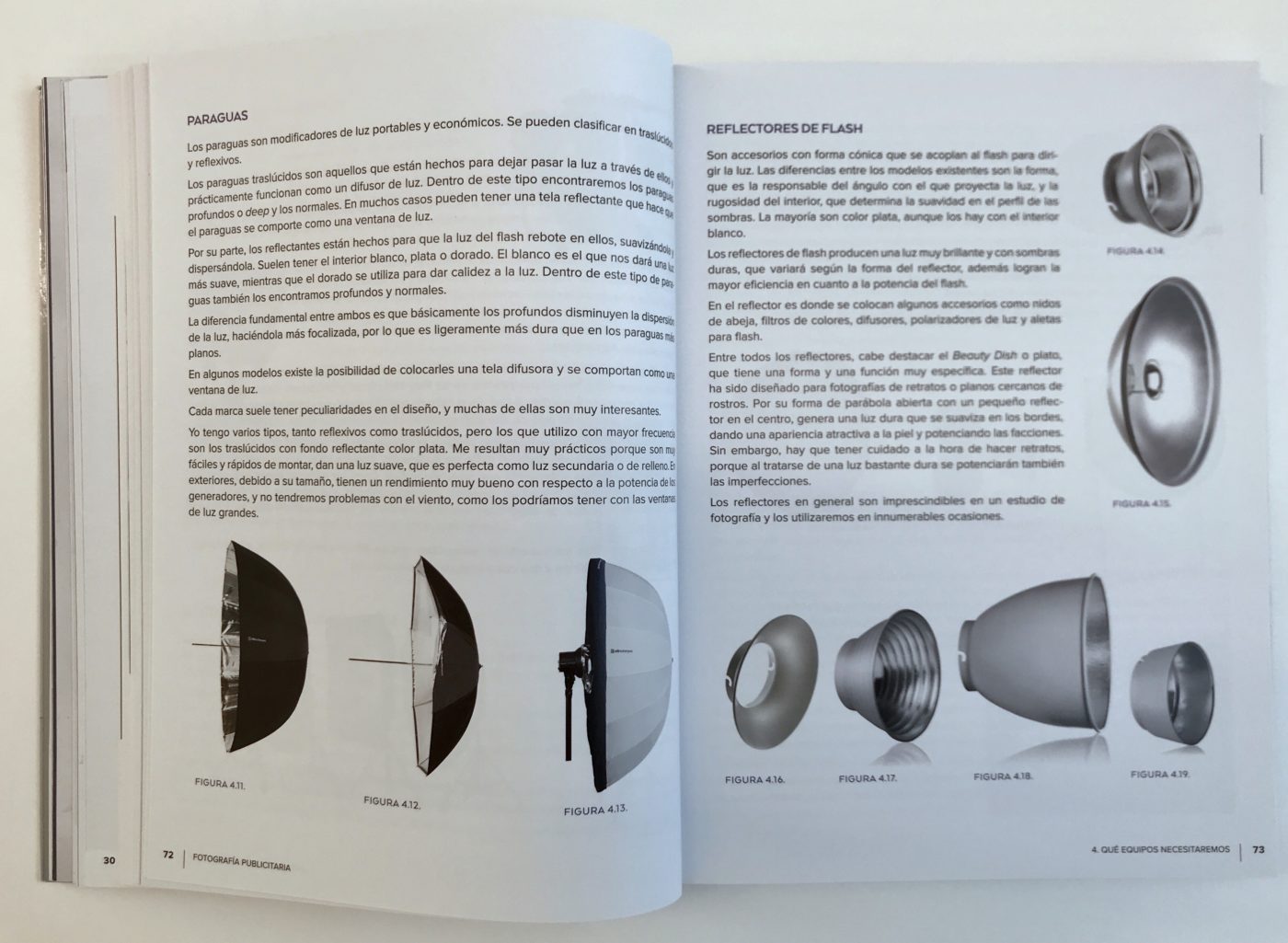
CHAPTER 5: APPLICATIONS
In this chapter you will see step by step the editing of an example image in both Lightroom and Photoshop. Through the same image that explains the intention and the shot, you will see how the desired result is achieved in both editing programs.
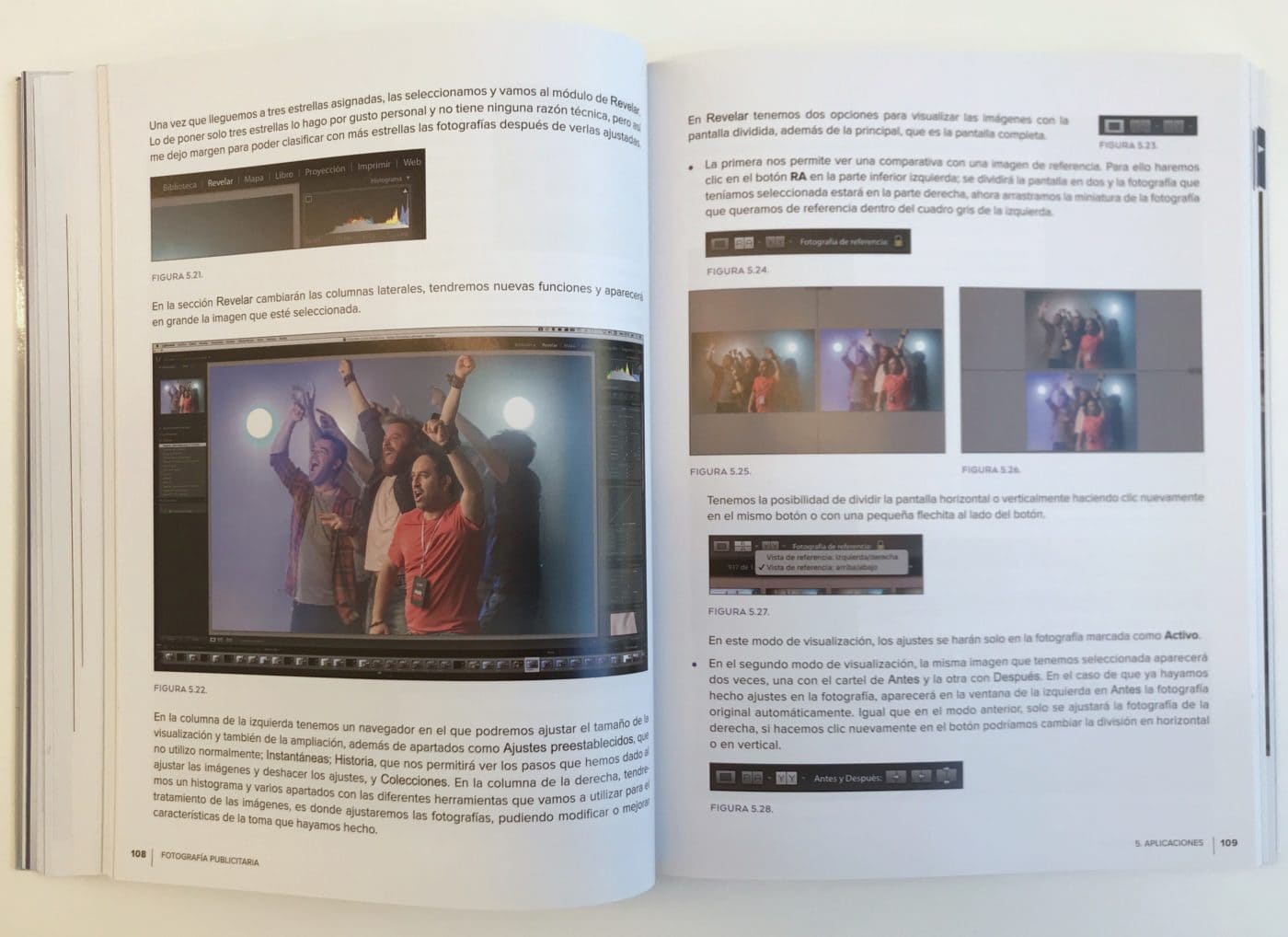
CHAPTER 6: USE CASES
Through real cases, you can see how to treat the different types of objects or types of advertising photography.
You have at least one case study explained step by step for each of the following situations:
Opaque objects, satin opaque, glossy opaque, translucent objects, advertising still life, photography of people, photography in motion or photography with special effects. In short, more than 16 cases explained exhaustively throughout the process, from the idea to post-production.
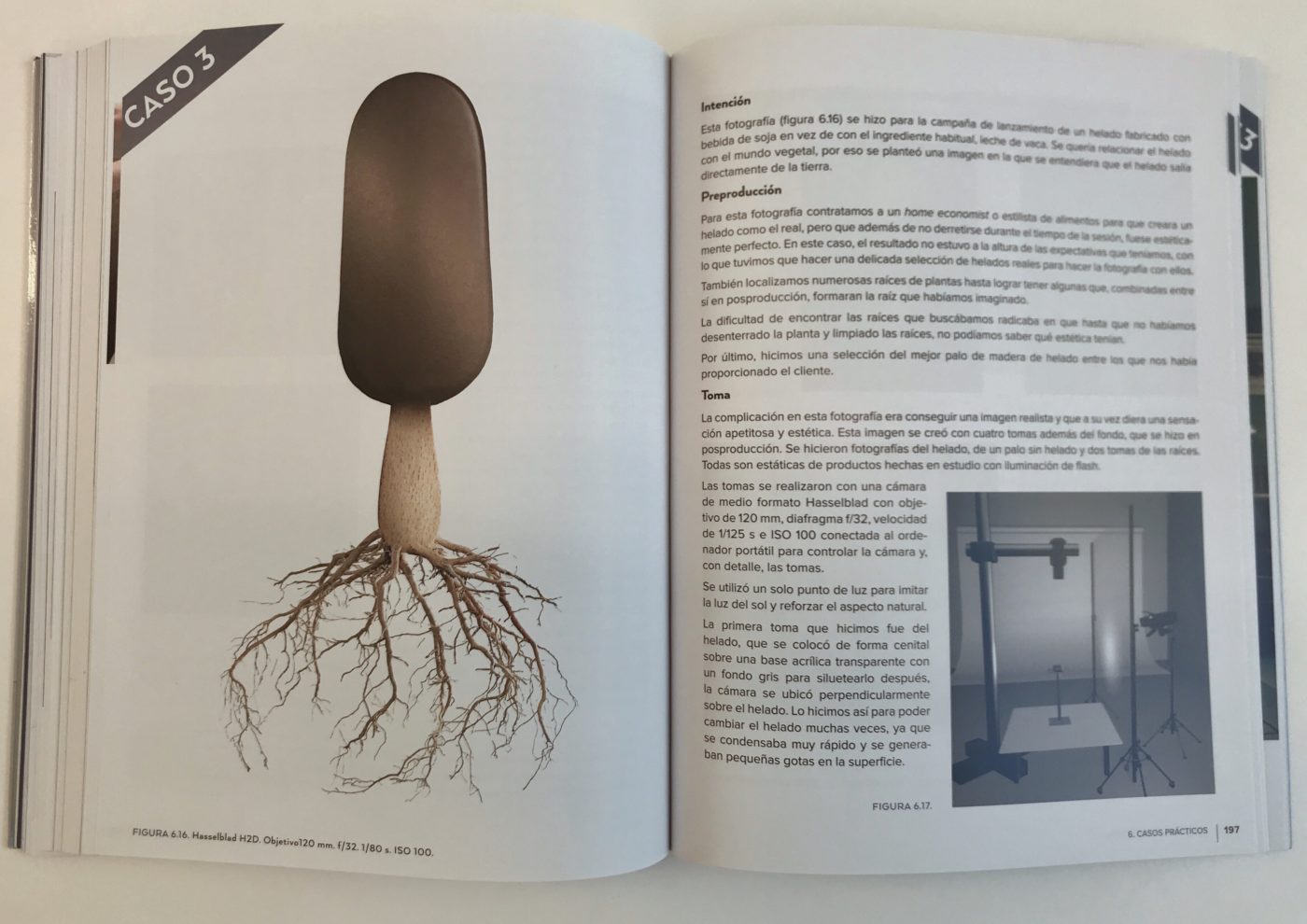
To finish, I take these words from the author:
Advertising photography is like an adventure in which every time we enter a project, we know where we want to go, but the path will be different and it will require our creativity and technique to achieve a great image.
Eduardo Diaz Bourgeot
ABOUT THE AUTHOR
Eduardo Díaz Bourgeot is a third generation photographer. He begins his career at the age of 19 specializing in advertising photography, a specialty in which he has worked for more than 30 years.
He has won numerous awards such as the Cannes Lions, the Sun, LUX, FIAP, or The New York Festival among others.
He has worked and works for the main advertising agencies and with clients such as Vodafone, Iberia, Endesa, Peugeot, Ausonia, Cinfa, Bankia, Renfe and many more.
You can see his work by visiting his website: www.diazbourgeotestudio.comand on Instagram @eduardo_diaz_bourgeotor Facebook.
DETAILS
- Title: Advertising photography. Image's power
- Softcover: 270 pages
- Publisher: ANAYA MULTIMEDIA (Photo Club)
- Language: Spanish
- Dimensions: 18 x 24 cm (approx)
- Price: €9.45
THE BEST
For me, without a doubt, the images of the different advertising campaigns that accompany this book stand out. They are a true marvel, as well as the practical cases that are detailed in each part of the process.
It is also very interesting to know in an orderly and detailed way the photographic process of something as complex as an advertising photograph, from the initial briefing to post-processing.
I also found the section where you treat an image with the Lightroom and Photoshop editors very complete and accurate. It is very interesting to see what tools he uses, what workflow he establishes and what touch-ups he gives to the images and why.
WORST
It may seem like a dense book, but because I understand that the theme requires it. Not surprisingly, it has a lot of very detailed information on everything related to advertising photography.
CONCLUSIONS
For anyone who masters the different photographic techniques, who knows light in depth, and who wants to enter the world of advertising photography, this book can be a great option as a guide to take the first steps or to perfect those that have already been given.
I hope this recommendation has been useful to you. Do you know anyone else who might be interested in checking it out? Well, share it on social networks to help us reach more people and be able to continue creating content for you. Thank you very much and until the next reading ;).

